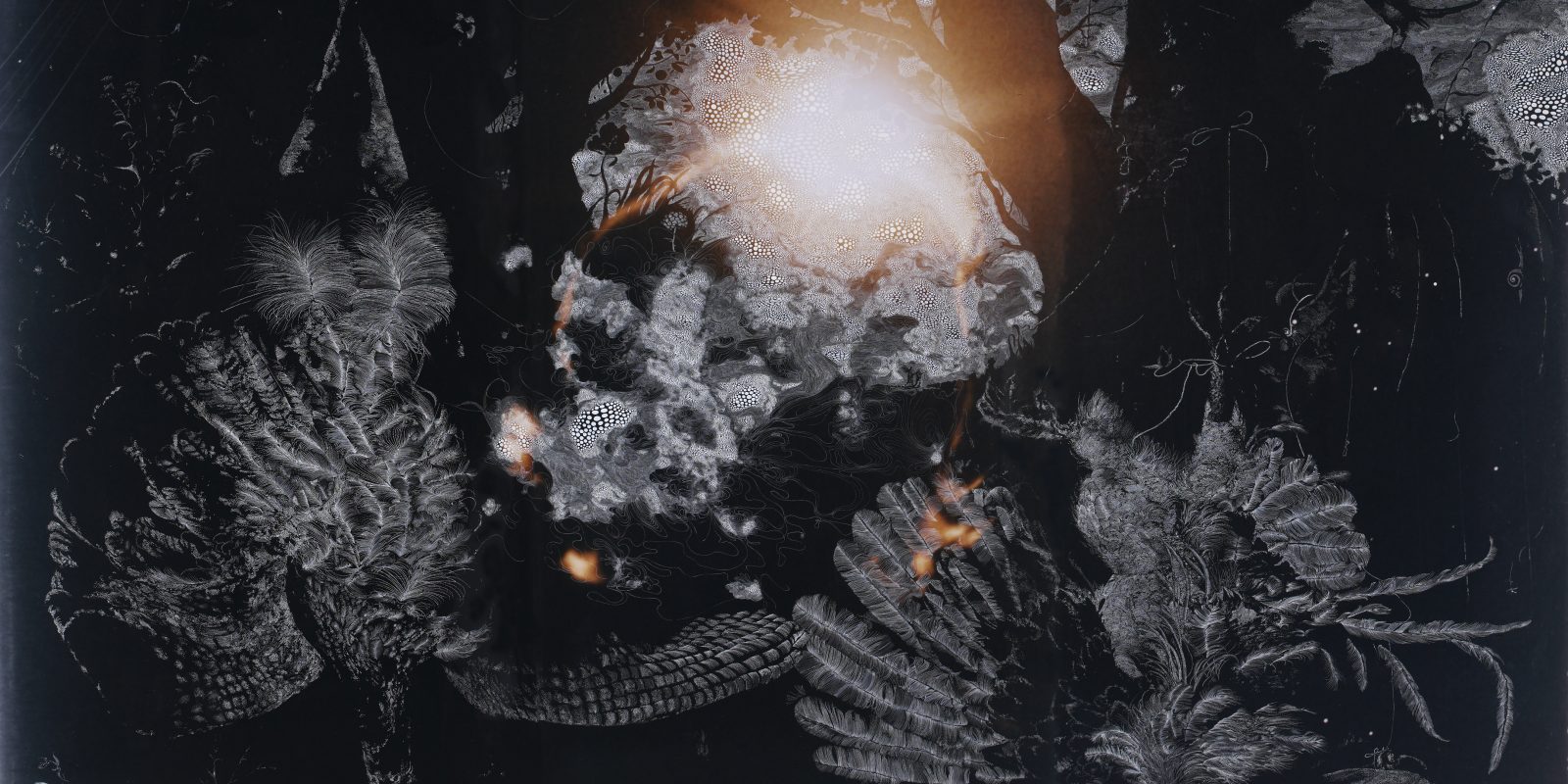
Sebastiaan Bremer's 102 1/2 x 118-inch hand-painted chromogenic print, "Dead Cock and Contemplative Magpie." Courtesy of Sebastiaan Bremer
Art Is Everywhere
TCU’s campus features works from its 1,200-piece permanent collection. We turn the spotlight on a few of them.
TCU’s art collection includes some 1,200 objects, ranging from outdoor sculptures to oil portraits gracing campus interiors to works by such well-known artists as Rembrandt and Salvador Dalí.
Although the collection has no curator, Sara-Jayne Parsons, director of the Art Galleries at TCU, often gets the call when a piece needs to be moved or installed. She uses the opportunity to teach graduate students working in campus galleries how to pack, transport and install art with security hangers that can’t be pulled off the wall.
Such protective measures are necessary. In 2001, dozens of items from the university’s collection of pre-Columbian pottery, now on display in Scharbauer Hall, were stolen; most were recovered in Houston. Alex Hidalgo, associate professor of Latin American history, led a graduate seminar in which students explored the heist.
Parsons hopes at some point to hire staff to catalog and curate the collection.
Among the art collection’s many standouts, Parsons is partial to “Pink Cloud,” an oil landscape by Samuel Ziegler ’24 (MEd ’51), chair of the art department from 1925 to 1953. TCU Magazine staff and contributors, over the course of several campus art walks, compiled a list of favorite works.
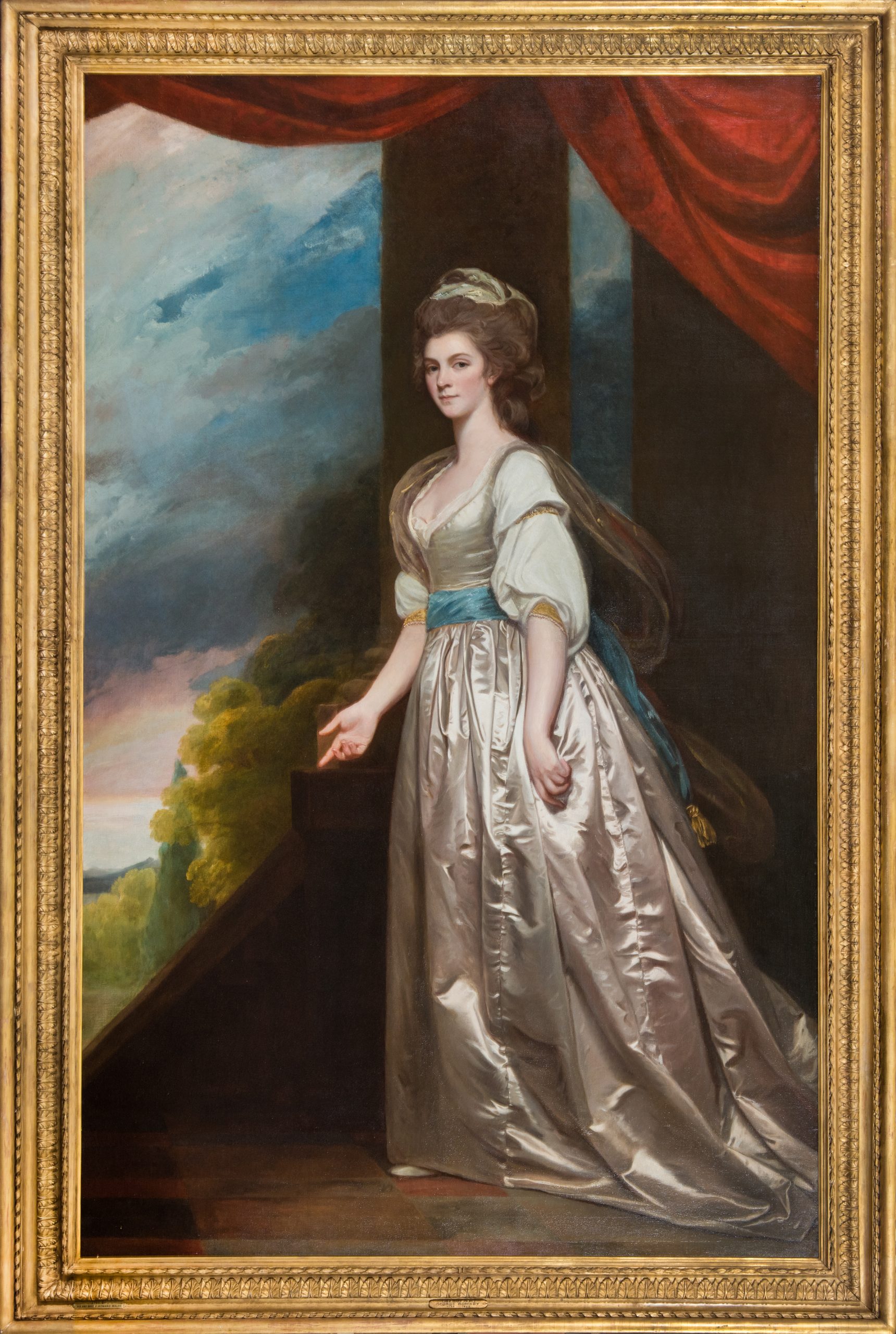
Oil on Canvas
94 x 68 inches | TCU Library
A Portrait of Presence
“Lady Mary Every” | George Romney, 1780
“Full-length and life-sized, the portrait shows her ladyship in front of a column at the top of a set of stairs,” writes Janelle Montgomery ’17 MA in “Every Picture Tells a Story,” an essay published in the Romney Society journal. “Her body turns toward the stairs, but she gazes straight out of the picture with an air of self-possession.”
Things were looking up for Lady Mary Every at the time her portrait was painted. Sir Edward Every had inherited a baronetcy in Derbyshire, giving the couple new titles and land. Society painter George Romney depicted Lady Mary in fashionable clothes, gesturing toward the grounds.
Alas, her portrait was sold at Christie’s when an Every descendant settled with bankruptcy court in 1939. The oil painting was donated to TCU by Howard Walsh Sr. ’33 and Mary D. Walsh.
After Montgomery’s essay raised awareness of the painting’s whereabouts, a curator came calling; TCU lent the work to the Museo Civico San Domenico for its “L’arte della moda” exhibition in Forli, Italy, in 2023.
— Laura Samuel Meyn
A Reverie on Remains
“Dead Cock and Contemplative Magpie” | Sebastiaan Bremer, 2007
Seventeenth-century Dutch still life artists prompted viewers to contemplate mortality through themes of death and decay — showing fruit that’s beginning to rot and game after the hunt. Contemporary Dutch artist Sebastiaan Bremer follows the tradition in “Dead Cock and Contemplative Magpie,” donated to TCU by Mr. and Mrs. James Pallotta.
The composition is anchored by a dead turkey on the left, a dead rooster on the right and a blinding sunrise visible between trees. From the top right corner, a magpie surveys the scene, which is dotted with some recognizable forms — a bird skull, a snail — and areas of abstraction.
Bremer, now based in Brooklyn, forged a special connection with TCU through Scott Sullivan, retired dean of the College of Fine Arts. Bremer has credited Sullivan’s 1984 art history book, The Dutch Gamepiece, as inspiration for his work. Fort Worth Contemporary Arts at TCU hosted a mid-career retrospective of Bremer’s work in 2016.
— Laura Samuel Meyn
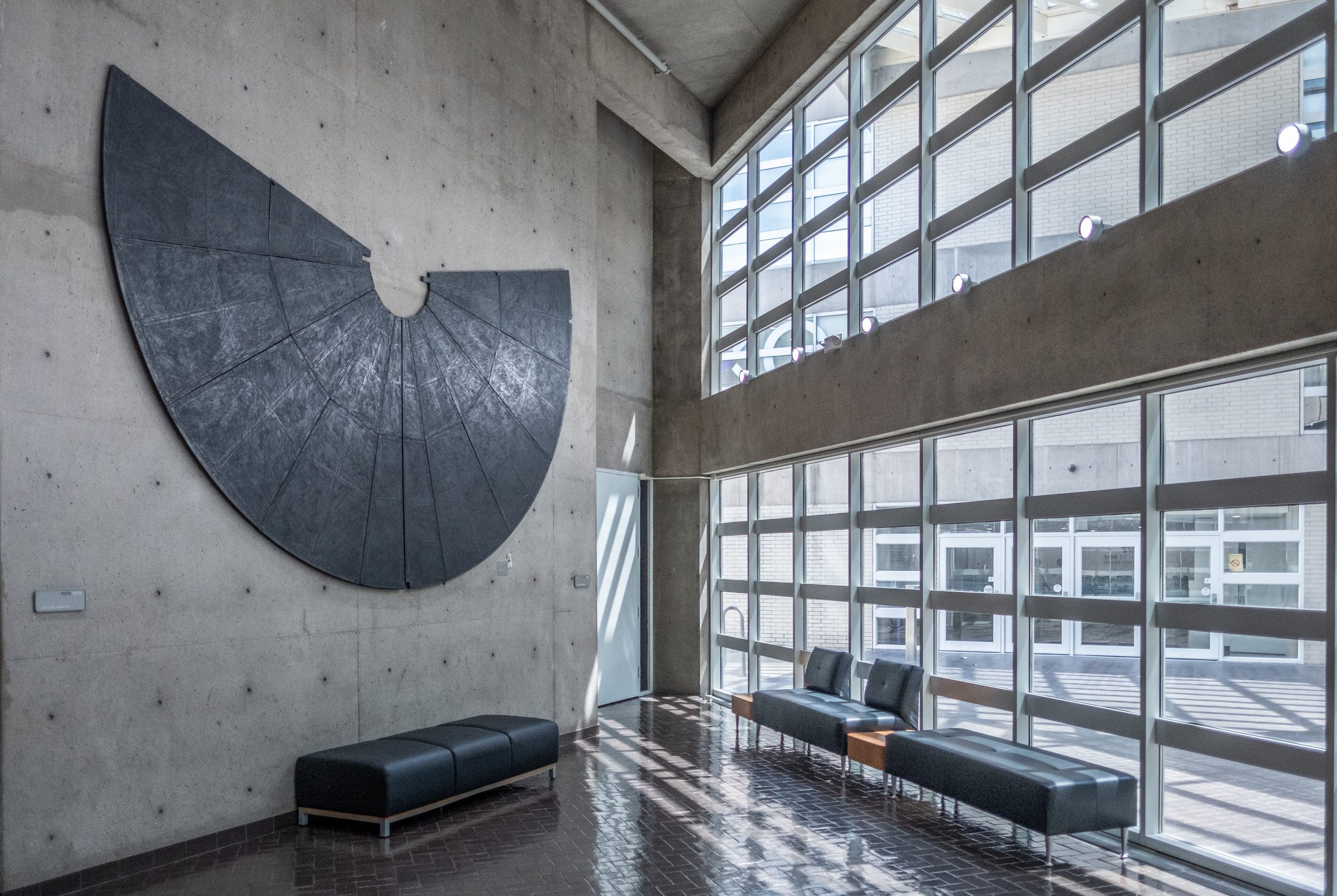
Wood, Paper and Graphite
10 x 16 feet | Moudy North
Dark Majesty
“Echo (050)” | Joe Guy, 1982
With a wingspan of about 16 feet, “Echo (050)” by Joe Guy ’77 (MFA ’79) greets visitors entering the Moudy North lobby. Guy created the piece in 1982 and later donated it to TCU. Its sheer size, distinctive shape and dark textured panels resembling metal make for an imposing piece.
A few years after making “Echo (050),” the artist was spotlighted in a solo show at the Dallas Museum of Art. A museum press release described his method: “Guy creates his sculptural paintings by stretching mulberry or block-printing paper over redwood grids and joining them together with hinges. He then covers the surface with a combination of acrylic medium, graphite and a small amount of pigment, creating a monochromatic gray/black surface that both attracts and reflects light.”
— Siena Frolich
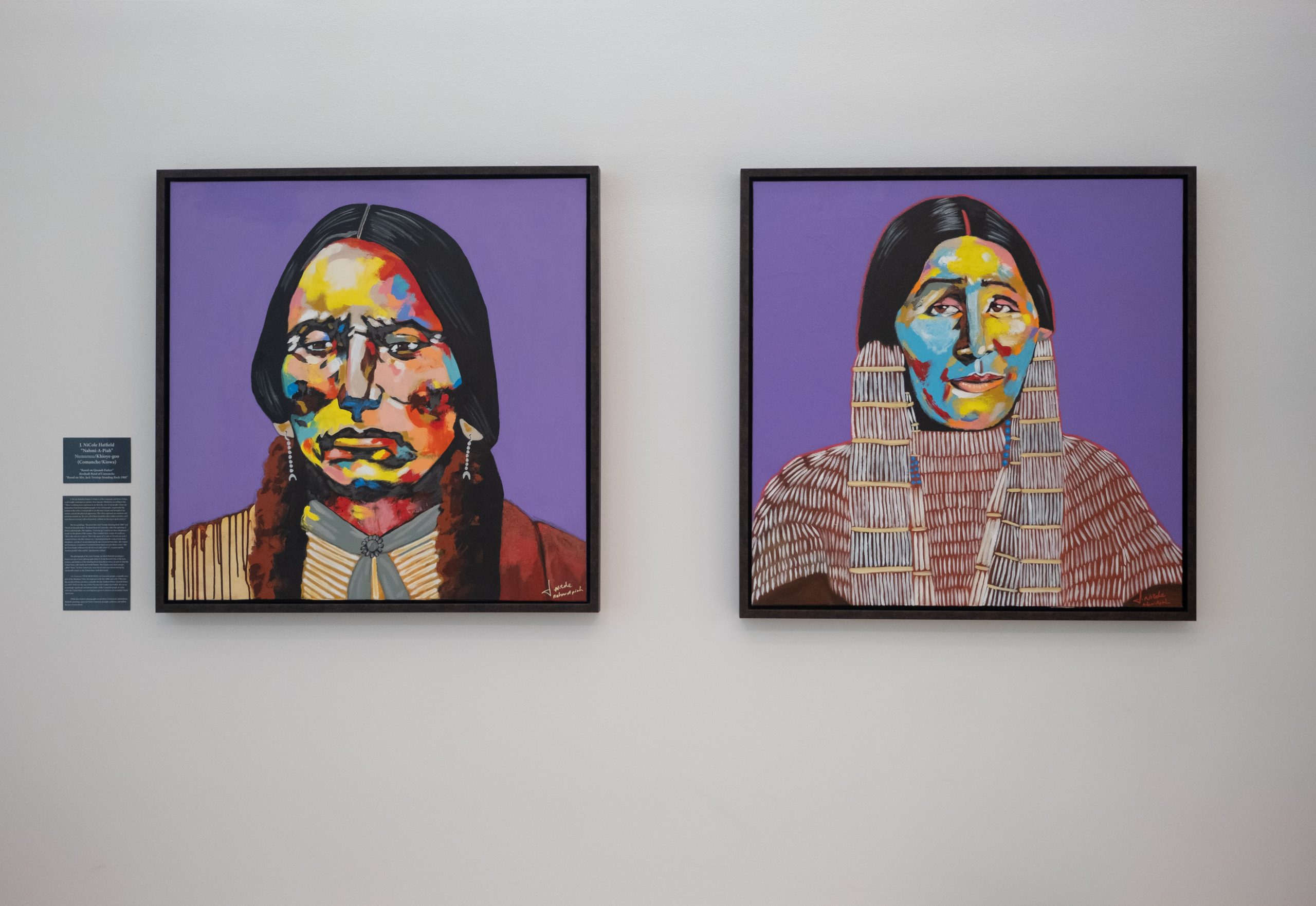
Acrylic and Paint Pen on Canvas
36 x 36 inches | The Harrison
Expressive Essence
“Based on Quanah Parker” | J. NiCole Hatfield (Nahmi-A-Piah), circa 2022
“Based on Mrs. Jack Treetop — Standing Rock 1908” | J. NiCole Hatfield (Nahmi-A-Piah), circa 2022
Nahmi-A-Piah is the Comanche name of contemporary painter J. NiCole Hatfield. Two of her kaleidoscopic paintings are displayed in The Harrison, TCU’s administration building.
“Based on Quanah Parker” was inspired by an 1892 black-and-white photo of the famous Comanche chief. From this austere historical document Hatfield conjures an explosion of vibrant color.
“Based on Mrs. Jack Treetop – Standing Rock 1908” also bursts with color, and the elements of the subject’s traditional Sioux attire are depicted in an eye-grabbing pattern of short lines.
About her work, the artist commented: “We carry all of these beautiful colors within ourselves, and I want them to resonate with each portrait.”
— Robert Carter
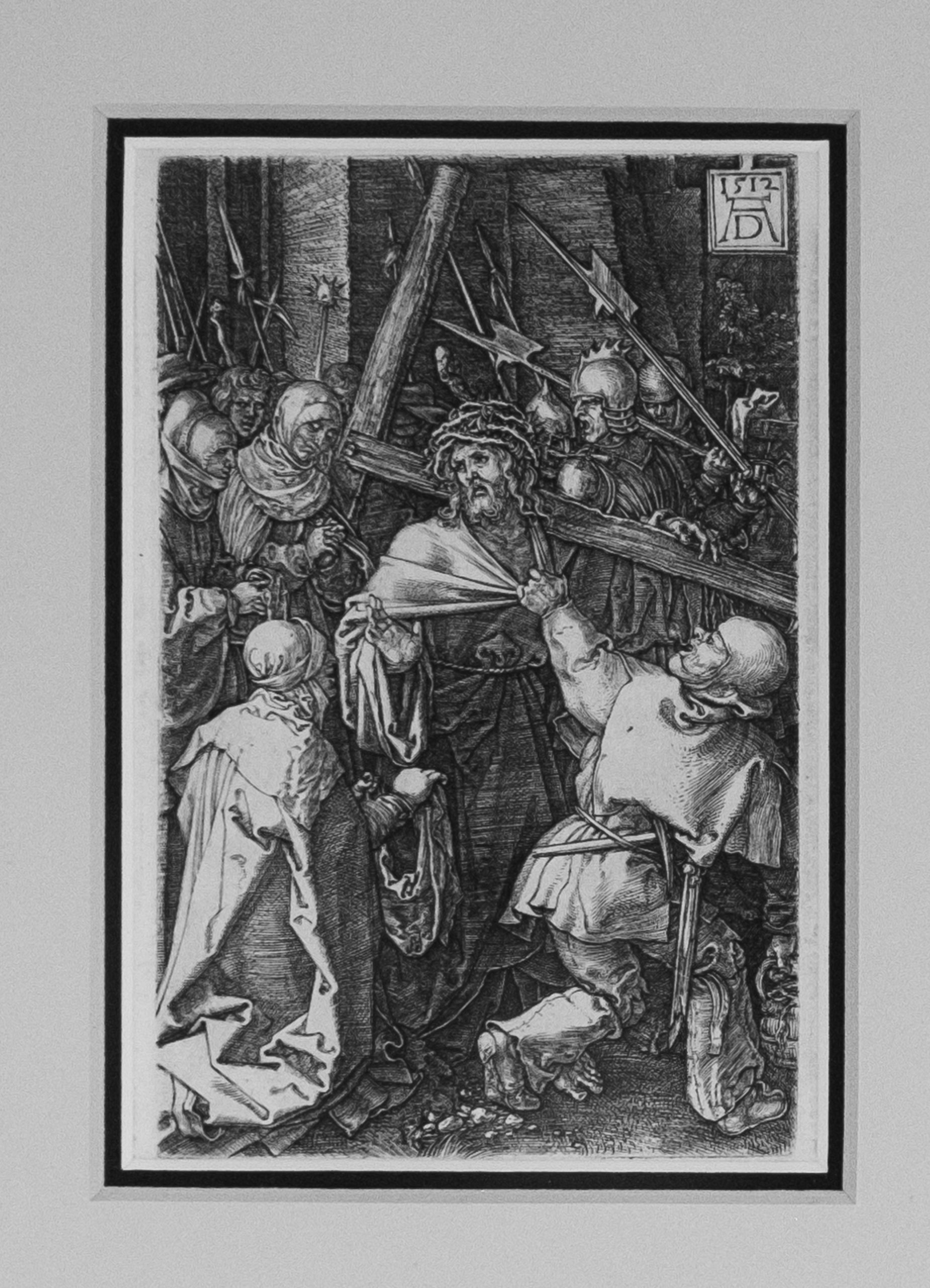
Engraving
4 7/8 x 3 1/2 inches | Mary Couts Burnett Library Special Collections
Sacred Precision
“Christ Carrying the Cross” | Albrecht Dürer, 1512
Besides being a celebrated painter and theorist, Albrecht Dürer (1471-1528) is regarded as one of the great masters of printmaking. His 1512 engraving “Christ Carrying the Cross” shows his skill at rendering beautiful and complex compositions with an astonishing degree of detail. Folds of fabric, the grain of the cross, a gnarled hand clutching at Christ’s robes are all meticulously portrayed in an image similar to the size of a 21st-century postcard.
This work and several other old master prints were believed to be missing from TCU’s permanent art collection for several decades. They were recently rediscovered in a bookcase in the Brown-Lupton University Union and are now on display in Special Collections in the Mary Couts Burnett Library.
— Robert Carter
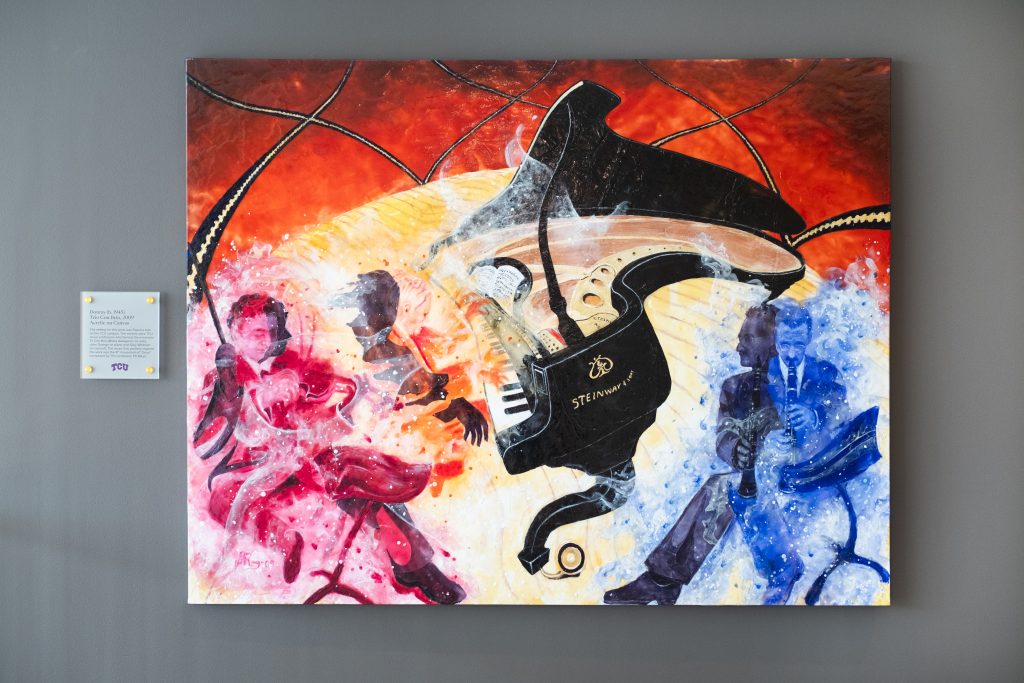
Acrylic on Linen Canvas
60 x 78 inches | TCU Music Center
Melodic Movement
“Trio Con Brio” | Donray, 2009
The creativity, passion and collaboration involved in composing and performing music is on display in Donray’s “Trio Con Brio.” The artist depicts a performance by three TCU music professors: violist Misha Galaganov, pianist John Owings and clarinetist Gary Whitman.
Each musician is rendered in a different vibrant color, their movements evident in shadowy repetitions of their forms. The crosshatch design in the background reveals the concert’s setting: TCU’s PepsiCo Recital Hall.
Donray said the painting was inspired by the trio’s performance of the final movement of “Orion,” a work composed for them by Till MacIvor Meyn, professor of music theory and composition. The painting, after being featured in various Steinway galleries in North Texas, now calls the second floor of the TCU Music Center home.
— Siena Frolich
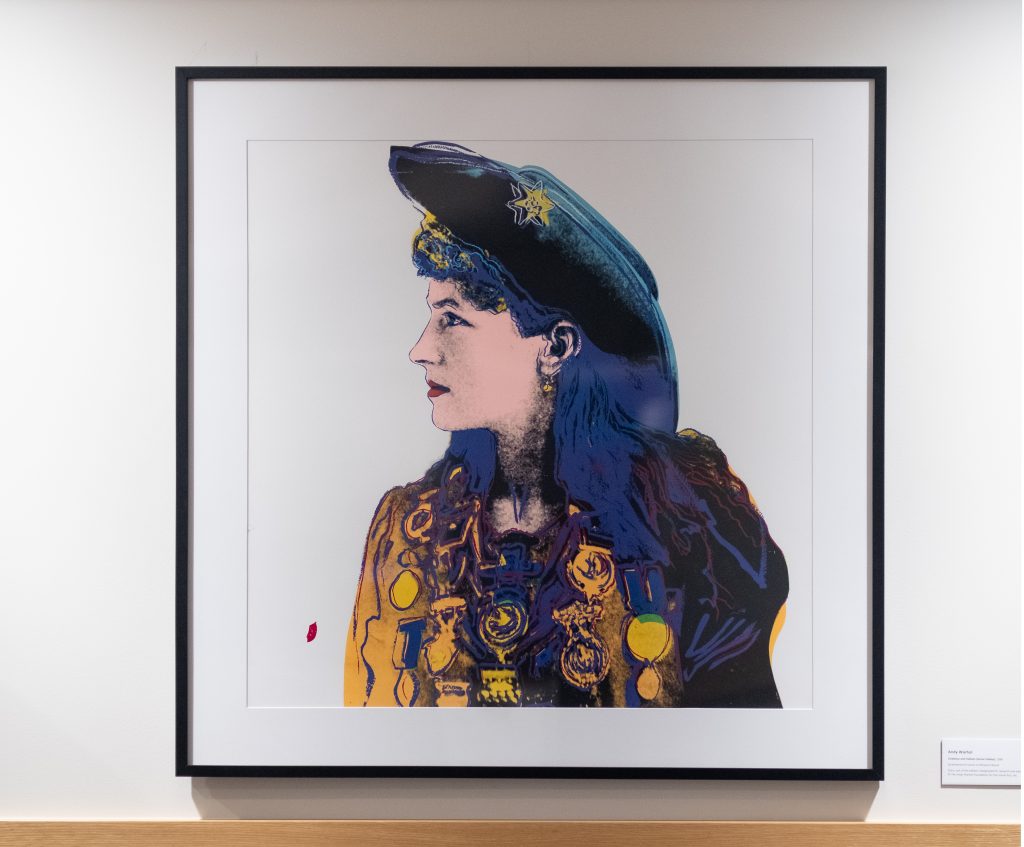
Screen Print
36 x 36 inches | Mary Couts Burnett Library Special Collections
Shooting Star
“Annie Oakley 378” | Andy Warhol, 1986
As a child, pop artist Andy Warhol found copious artistic inspiration in Western films. His boyhood fascination led to this 1986 screen print of Annie Oakley, the Ohio markswoman and entertainer known as Little Sure Shot.
TCU owns an original screen print of Warhol’s “Annie Oakley 378.” The unique yellow-and-blue-hued variation of the classic, one of 250 prints, was donated to TCU’s permanent art collection by the Andy Warhol Foundation.
The print was one feature of Warhol’s 10-installment Cowboys and Indians series, which intended to reproduce the nostalgic media depictions of a romanticized American West — a fitting approach for an artist forever remembered for his colorful interpretations of the forces that shaped popular culture.
— Caroline Collier

White Ink on Black Paper
34 x 41 inches | Moudy North
Frog Fusion
“140 Hours” | D.J. Perera, 2023
Dhananjaya “D.J.” Perera ’10 created the “140 Hours” artwork, on display in Moudy North, which pays homage to TCU’s iconic Horned Frog mascot.
He created the piece using a technique called stippling — bringing a visual to life through a compilation of dot marks. The work, Perera said, “is part of a larger series featuring 19 hyperrealistic pointillism pieces that originated during the height of the pandemic in 2020.”
As Covid-19 shifted societal dynamics, Perera’s creative style also transformed, transitioning from painting to drawing. “What is especially unique about this milestone piece,” he said, “is that I challenged myself to work inversely with white ink on a black surface as opposed to the traditional black ink on a white surface.”
The drawing artfully integrates hidden images and text. Perera encourages viewers to take their time to uncover the clues carefully tucked into his piece.
— Adrianna Santos

Your comments are welcome
Comments
Related reading:
Research + Discovery
Advocating for Youth
New major provides experience helping children in settings outside the classroom.
Features
Building a Brand
Sportscaster Newy Scruggs mixes charisma with business acumen in a thriving on-camera career.
From the Chancellor
Fall is my favorite time of year because we welcome the newest class of Horned Frogs into our community.